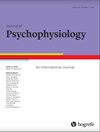Negative Affect-Related Autonomic Arousal Mediates the Association between Baroreflex Dysfunction and Insulin Resistance in Non-Diabetic Young Adults.
IF 0.9
4区 心理学
Q4 NEUROSCIENCES
引用次数: 1
Abstract
Autonomic dysfunction, in particular under-regulation of heart rate (HR) by the baroreflex, is implicated in development of insulin resistance (IR). According to reactivity hypothesis, sympathetic response to stressors may be more sensitive at predicting IR than baroreceptor sensitivity (BRS), a baseline measure of baroreflex functioning. Using ecological momentary assessment (EMA) of negative affect coupled with minute-to-minute HR and heart-rate variability (HRV) monitoring, we examined whether negative affect (NA)-related autonomic arousal mediates the association of BRS with IR. At baseline, BRS was measured, and fasting serum glucose and insulin levels were collected from 178 young adults (18-39 years old), from which homeostasis model assessment of IR (HOMA-IR) and beta-cell functioning (HOMA %B) were derived. Participants subsequently underwent one day of Holter HR and HRV monitoring while reporting negative affect levels via EMA. Multilevel modeling was used to assess the associations of momentary negative affect with HR and low- (LF) and high-frequency (HF) HRV during the 5-minute intervals following each EMA reading. Structural equation modeling was then used to determine whether individual differences in these associations mediated the association of BRS with IR, measured by HOMA-IR, HOMA %B, and insulin levels. As predicted, BRS was negatively associated with the IR (β = -.17, p = .024). However, NA-related autonomic arousal mediated their association, accounting for 56% of the covariance between BRS and IR. Not only do these results provide support for reactivity hypothesis, they reveal a potential point of intervention in the treatment of affective dysregulation.负性情感相关的自主唤醒介导非糖尿病青年压力反射功能障碍与胰岛素抵抗之间的关系。
自主功能障碍,特别是在压力反射对心率(HR)的调节下,与胰岛素抵抗(IR)的发展有关。根据反应性假说,对压力源的交感神经反应在预测IR方面可能比压力感受器敏感性(BRS)更敏感,压力感受器灵敏度是压力反射功能的基线测量。使用负面影响的生态瞬时评估(EMA),结合分钟到分钟的HR和心率变异性(HRV)监测,我们检查了负面影响(NA)相关的自主觉醒是否介导了BRS与IR的关联。在基线时,测量了BRS,并收集了178名年轻人(18-39岁)的空腹血糖和胰岛素水平,β细胞功能(HOMA%B)的稳态模型评估。参与者随后接受了为期一天的动态心电图HR和HRV监测,同时通过EMA报告负面影响水平。在每次EMA读数后的5分钟间隔内,使用多水平建模来评估瞬时负面影响与HR以及低(LF)和高(HF)HRV的关系。然后使用结构方程建模来确定这些关联的个体差异是否介导了BRS与IR的关联,通过HOMA-IR、HOMA%B和胰岛素水平来测量。正如预测的那样,BRS与IR呈负相关(β=-.17,p=0.024)。然而,NA相关的自主觉醒介导了它们的相关性,占BRS和IR之间协方差的56%。这些结果不仅为反应性假说提供了支持,还揭示了治疗情感失调的潜在干预点。
本文章由计算机程序翻译,如有差异,请以英文原文为准。
求助全文
约1分钟内获得全文
求助全文
来源期刊

Journal of Psychophysiology
医学-神经科学
CiteScore
2.60
自引率
7.70%
发文量
25
审稿时长
>12 weeks
期刊介绍:
The Journal of Psychophysiology is an international periodical that presents original research in all fields employing psychophysiological measures on human subjects. Contributions are published from psychology, physiology, clinical psychology, psychiatry, neurosciences, and pharmacology. Communications on new psychophysiological methods are presented as well. Space is also allocated for letters to the editor and book reviews. Occasional special issues are devoted to important current issues in psychophysiology.
 求助内容:
求助内容: 应助结果提醒方式:
应助结果提醒方式:


